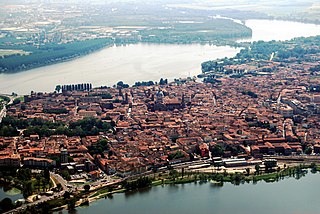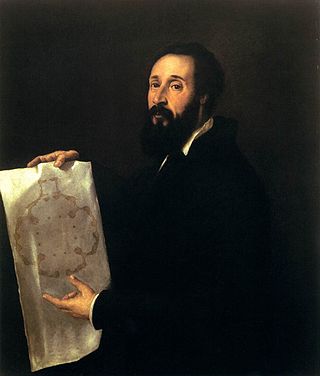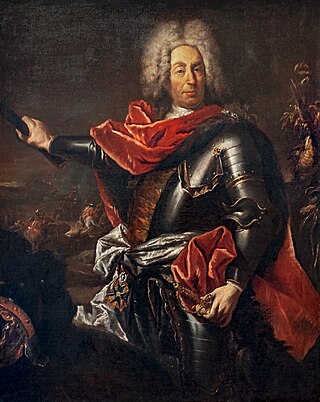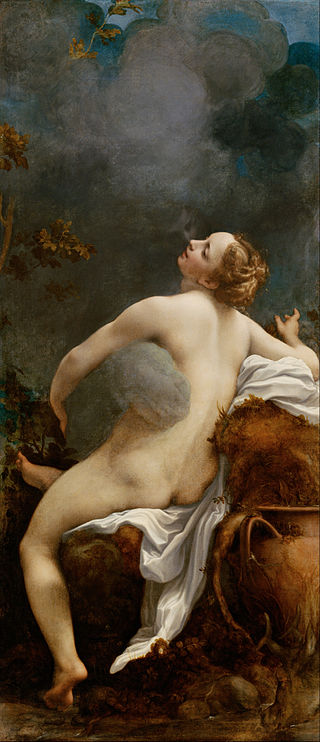
Daniel Nijs (or Nys) (1572-1647) was a Flemish art dealer.

Daniel Nijs (or Nys) (1572-1647) was a Flemish art dealer.

Born in Wesel into a family of Protestant refugees from the Spanish Netherlands (now Belgium), he moved to Venice in 1596. There he worked for the firm of his cousins, the Gabrys, while also laying the foundation of his own firm. [1] By 1615 he had made his fortune and possessed a major art collection which was described by Vincenzo Scamozzi, Giulio Cesare Gigli and Constantijn Huygens. In 1622 he came into contact with Ferdinando Gonzaga, Duke of Mantua to whom Nijs began supplying luxury goods. Five years later the 7th Duke, Vincenzo II Gonzaga, [2] who was in dire financial straits, agreed to sell the cream of the paintings in the Gonzaga art collection to Nijs. Nijs, in turn, was interested in acquiring the paintings in order to sell them to Charles I of Great Britain. [3] Its works included: [4]
Vincenzo II's successor Charles I of Gonzaga-Nevers was persuaded to sell statues and further paintings to Nijs, leading to the bankruptcy of the dealer. Among the works included in the second part of the sale are the Triumphs of Caesar now at Hampton Court. Nijs died in London in 1647.

Mantua is a comune (municipality) in the Italian region of Lombardy, and capital of the province of the same name.

Giulio Pippi, known as Giulio Romano and Jules Romain, was an Italian Renaissance painter and architect. He was a pupil of Raphael, and his stylistic deviations from High Renaissance classicism help define the sixteenth-century style known as Mannerism. Giulio's drawings have long been treasured by collectors; contemporary prints of them engraved by Marcantonio Raimondi were a significant contribution to the spread of sixteenth-century Italian style throughout Europe.

The Duchy of Mantua was a duchy in Lombardy, northern Italy. Its first duke was Federico II Gonzaga, member of the House of Gonzaga that ruled Mantua since 1328. The following year, the duchy also acquired the March of Montferrat, thanks to the marriage between Gonzaga and Margaret Paleologa, Marchioness of Montferrat.
Giulio Mancini was a seicento physician, art collector, art dealer and writer on a range of subjects. His writings on contemporary artists like Caravaggio and Annibale Carracci remain one of our earliest sources of biographical information; his Considerazioni being an important source on art in early 17th-century Rome.

The Palazzo Ducale di Mantova is a group of buildings in Mantua, Lombardy, northern Italy, built between the 14th and the 17th century mainly by the noble family of Gonzaga as their royal residence in the capital of their Duchy. The buildings are connected by corridors and galleries and are enriched by inner courts and wide gardens. The complex includes some 500 rooms and occupies an area of c. 34,000 m2, which make it the sixth largest palace in Europe after the palaces of the Vatican, the Louvre Palace, the Palace of Versailles, the Royal Palace of Caserta and the Castle of Fontainebleau. It has more than 500 rooms and contains seven gardens and eight courtyards. Although most famous for Mantegna's frescos in the Camera degli Sposi, they have many other very significant architectural and painted elements.

Marshal Johann Matthias Reichsgraf von der Schulenburg was a German aristocrat and general of Brandenburg-Prussian background who served in the Saxon and Venetian armies in the early 18th century and found a second career in retirement in Venice, as a grand collector and patron. His sister was Melusine von der Schulenburg, Duchess of Kendal. His father was Gustavus Adolphus, Baron von der Schulenburg.

Bernadino Campi (1522–1591) was an Italian Renaissance painter from Cremona, who worked in Reggio Emilia. He is known as one of the teachers of Sofonisba Anguissola and of Giovanni Battista Trotti. In Cremona, his extended family owned the main artistic studios. Giulio Campi and Antonio Campi, half-brothers, were distant relatives of Bernardino; the latter is generally considered the most talented of the family. All were active and prominent painters locally. Influences on Bernardino include local Cremonese such as Camillo Boccaccino and artists from neighbouring regions such as Correggio, Parmigianino and Giulio Romano. He made a number of sets of copies of the Eleven Caesars by Titian, then in the Gonzaga collection, adding one of Domitian, which he based on a work by Giulio Romano. Titian's originals were all lost in an 18th-century fire in Madrid.

Nicolas Régnier (1591–1667), known in Italy as Niccolò Renieri, was a painter, art dealer and art collector from the County of Hainaut, a French-speaking part of the Spanish Netherlands. He is often referred to as a Flemish artist because this term was often used to designate people from the Spanish Netherlands. After training in Antwerp, he was active in Italy where he was part of the international Caravaggesque movement. His subjects include genre scenes with card players, fortune tellers, soldiers and concerts, religious scenes, saints, mythological and allegorical scenes, and portraits. He also painted a few scenes with carnivals.

The Orleans Collection was a very important collection of over 500 paintings formed by Philippe II, Duke of Orléans, mostly acquired between about 1700 and his death in 1723. Apart from the great royal-become-national collections of Europe it is arguably the greatest private collection of Western art, especially Italian, ever assembled, and probably the most famous, helped by the fact that most of the collection has been accessible to the public since it was formed, whether in Paris, or subsequently in London, Edinburgh and elsewhere.

The Eleven Caesars was a series of eleven painted half-length portraits of Roman emperors made by Titian in 1536–1540 for Federico II, Duke of Mantua. They were among his best-known works, inspired by the Lives of the Caesars by Suetonius. Titian's paintings were originally housed in a new room inside the Palazzo Ducale di Mantova. Bernardino Campi added a twelfth portrait in 1562.

Vincenzo Campi was a 16th-century Italian painter working in Cremona during the Late Renaissance. Campi is best known as one of the first northern Italian artists to work in the Flemish style of realist genre painting.

Jacob Denys or Jacob Denys (II) (1644–1708) was a Flemish Baroque painter. His known works are mainly portraits. He also painted landscapes and history paintings. After training in Antwerp, he worked for a long time in Italy where he enjoyed the patronage of Duke of Mantua, Ferdinando Gonzaga, and the Duke of Tuscany, Cosimo III de' Medici.

Portrait of a Young Woman is an unfinished painting of around 1603, attributed to Rubens. It may be connected with a commission from Vincenzo Gonzaga, Duke of Mantua mentioned in Rubens' letters, during the latter's time in Italy and Spain, to paint aristocratic Spanish ladies to add to the duke's 'gallery of beauties'. Its subject's name is unknown. Two red seals on its back place it in Venice early in the 19th century and then in the collection of Sir John Hanmer at Bettisfield Park in Wrexham by the 1840s.

The Whitehall group is a term applied to a small circle of art connoisseurs, collectors, and patrons, closely associated with King Charles I, who introduced a taste for the Italian old masters to England. The term usually includes the advisors and agents who facilitated the group's acquisition of works of art.

The Holy Family with Saint Jerome is a 68 by 56 cm oil on poplar panel painting by Correggio. It dates to around 1515 and is now displayed in the East Closet of Hampton Court Palace as part of the Royal Collection. It has similarities with the Holy Family with the Infant Saint John the Baptist and so it probably dates to around the time Correggio painted the frescoes in the Camera di San Paolo or possibly slightly earlier. It shows the Holy Family and saint Jerome.

Daniel van den Dyck, known in Italy as Daniel Vandich was a Flemish painter, printmaker, architect and engineer. After training in Antwerp he left for Italy where he first worked in Venice and later became a court painter in Mantua. He was a versatile artist who created mythological and religious scenes, as well as portraits and flower-pieces.

Francesco Caldei called Francesco Mantovano or Mantovani was an Italian painter, mainly known as a still-life painter of flowers, fruits, animals and musical instruments. He also collaborated on garland and allegorical paintings. He was an art valuer and may also have been active as an art dealer. He worked first in Rome and then for the rest of his career in Venice. Here his flower pieces with their Roman flavour and the pleasantness of composition earned the artist considerable commercial success with the Venetian bourgeoisie.

The Fall of the Giants is a fresco by the Italian Renaissance artist Giulio Romano. Born in Rome Giulio Romano was a pupil of Raphael. In the year 1522 he was courted by Federico II Gonzaga, the ruler of Mantua, who wanted him as his court artist as he was especially attracted by his skill as an architect. In the year 1524 Romano moved to Mantua where he remained for the rest of his life. According to Vasari, Baltasare Castilliogne was delegated by Federico II Gonzaga to procure Romano to execute paintings and architectural projects in the city of Mantua, Italy. His masterpiece of architecture and fresco painting in that city is the Palazzo del Te, with its famous illusionistic frescos. In one of rooms of palazzo, the Sala dei Giganti Giulio Romano had depicted the Gigantomachy, an episode derived from Greek mythology. The fresco was created between 1532 and 1534 and it was based on Ovid's Metamorphoses, a narrative poem consisting of 15 books that was written in Latin around 8 C.E. The episode of Gigantomachy depicts Jupiter defeating the Giants with his lightning. According to other versions of the myth, Jupiter resisted the Giants' assault thanks to the intervention of Pan or of the asses of Silenus and Bacchus. Nevertheless, in the 16th century in Italy it was uncommon to hear Latin. Texts were changed in structure and substance when transferred to Vulgate, so it should be understood that Giulio Romano had used the vernacular translation of the Metamorphoses for his Gigantomachy in the Palazzo del Te. The subject was very popular in the fine arts of the Cinquecento, once for sure because of its inherent possibilities for effective aesthetic design, on the other hand because this myth was important for the self-image of a patron of that time expressing religious, moral, political ideas.

The Fasti of the Gonzagas or Gonzaga Cycle is a 1578-1580 cycle of oil on canvas paintings commissioned from Tintoretto and his workshop by Guglielmo Gonzaga to hang in two of the new rooms he had added to the Palazzo Ducale in Mantua. They celebrate the history of the Gonzaga family, particularly its military triumphs in the 15th and 16th centuries, and remained in the city until being taken to Venice in the early 18th century by the tenth and final Gonzaga duke Ferdinando Carlo Gonzaga. There they were bought in 1708 by Maximilian II Emanuel, Elector of Bavaria for his collection in Munich, where they still hang in the Alte Pinakothek.
![]() Media related to Daniël Nijs at Wikimedia Commons
Media related to Daniël Nijs at Wikimedia Commons